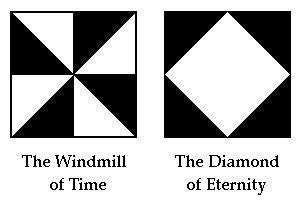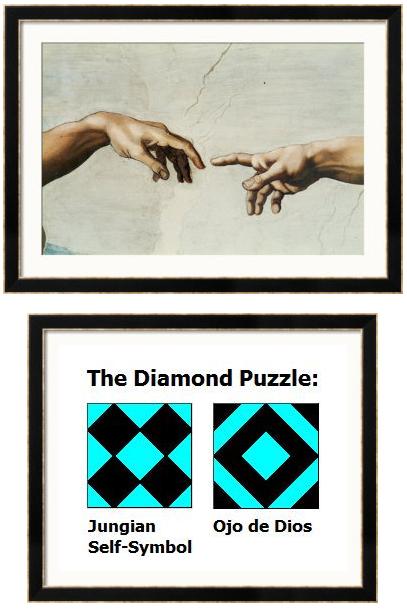Tuesday Weld in the 1972 film of Didion's Play It As It Lays :
Note the making of a matching pattern.
Tuesday Weld in the 1972 film of Didion's Play It As It Lays :
Note the making of a matching pattern.
(Continued from Tuesday, Oct. 2)
From today's online New York Times—
"The Schoenberg proved the highlight of the evening,
sandwiched between polished but otherwise routine
performances of Bach’s Keyboard Concerto No. 1
in D minor and Mozart’s Symphony No. 36 ('Linz'),
which ended the evening."
|
From a Wikipedia article— The Jew of Linz is a controversial 1998 book by Australian writer Kimberley Cornish. It alleges that the Austrian philosopher Ludwig Wittgenstein had a profound effect on Adolf Hitler when they were both pupils at the Realschule (lower secondary school) in Linz, Austria, in the early 1900s. One section of the article—
No-ownership theory of mind |
See also Dreamcatcher in this journal.
“When life itself seems lunatic,
who knows where madness lies?”
— Man of La Mancha

Perhaps the late Sidney Lumet?

The setting for the Sidney Lumet film "Deathtrap" (1982)
Alexander Grothendieck, Récoltes et Semailles , 18.5.9.5. e, p. 1181 :
Pour mettre la joie à son comble, j’ajoute que le dénommé Saavedra
semble avoir disparu de la circulation sans plus laisser aucune trace….
Du coup, l’histoire prend des allures de sombre intrigue policière.
Man of La Mancha :
"Who knows where madness lies?"
An author quoted here at 10 PM ET Monday, Nov. 24, 2014 :

And then there is author Dan McGirt :
|
It sounded fun, so I signed up — and soon learned writing a story set in someone else’s fictional world presents certain … challenges. It was an enjoyable experience, yet very different than being able to write and run with whatever crazy idea pops into my head. Trying to capture the feel of a game that is more based on action and blowing stuff up than on deep character moments (not that I would know much about that … ) was also a challenge. I experimented with things like using comic book sound effects, lean descriptions (do I really need to describe a fireball spell in detail?) and other tricks to keep things moving. I also got to add to Magicka lore. Often the answer to my questions about some bit of in-world history or “fact” was “Make something up.” So I did! (Often getting a response of … “Odin’s onions, no! You can’t do that!”) So I was thrilled and excited to contribute in a small way to the development of Midgård. The result is Magicka: The Ninth Element , in which four young Wizards are sent on a quest to pursue the mysterious Purple Wizard who has stolen a powerful artifact from the Order of Magick. Which powerful artifact? No one is quite sure (for reasons explained in the story). What does it do? Again, unclear. But it can’t be good. Thus our heroes Davlo, Grimnir, Fafnir and Tuonetar set out on their quest — and promptly go off the map. (I’m not even kidding. The Midgård map in the front of the book will of little use to you. But it’s pretty!) Will they survive the dangers of the Unmapped Lands? Will they catch the Purple Wizard in time? Will they save the world? Read the book to find out! |
(Continued from previous TARDIS posts)
Summary: A review of some posts from last August is suggested by the death,
reportedly during the dark hours early on October 30, of artist Lebbeus Woods.
An (initially unauthorized) appearance of his work in the 1995 film
Twelve Monkeys …
… suggests a review of three posts from last August.
Wednesday, August 1, 2012Defining FormContinued from July 29 in memory of filmmaker Chris Marker, See Slides and Chanting†and Where Madness Lies. See also Sherrill Grace on Malcolm Lowry. * Washington Post. Other sources say Marker died on July 30. † These notably occur in Marker's masterpiece |
Wednesday, August 1, 2012Triple FeatureFor related material, see this morning's post Defining Form. |
Sunday, August 12, 2012Doctor WhoOn Robert A. Heinlein's novel Glory Road— "Glory Road (1963) included the foldbox , a hyperdimensional packing case that was bigger inside than outside. It is unclear if Glory Road was influenced by the debut of the science fiction television series Doctor Who on the BBC that same year. In Doctor Who , the main character pilots a time machine called a TARDIS, which is built with technology which makes it 'dimensionally transcendental,' that is, bigger inside than out." — Todd, Tesseract article at exampleproblems.com From the same exampleproblems.com article— "The connection pattern of the tesseract's vertices is the same as that of a 4×4 square array drawn on a torus; each cell (representing a vertex of the tesseract) is adjacent to exactly four other cells. See geometry of the 4×4 square." For further details, see today's new page on vertex adjacency at finitegeometry.org. |
"It was a dark and stormy night."— A Wrinkle in Time
“And how do we keep our balance?
That I can tell you in one word!”
— Tevye in Fiddler on the Roof
“The object and characteristic of ‘traditions,’
including invented ones, is invariance.”
— Eric Hobsbawm, introduction (link added)
to The Invention of Tradition
“Math is all about questions and answers.”
— Prof. John D. McCarthy, Michigan State U.,
Monday afternoon, October 1, 2012
“Who knows where madness lies?”
— Man of La Mancha
(linked to here Monday morning)

The international standard format of high-definition
television (HDTV) has an aspect ratio of 16:9.
Related material (click for clearer image)—
Some background — Where Madness Lies.
Continued from July 29 in memory of filmmaker Chris Marker,
who reportedly* died on that date at 91 at his home in Paris.
See Slides and Chanting†and Where Madness Lies.
See also Sherrill Grace on Malcolm Lowry.
* Washington Post. Other sources say Marker died on July 30.
† These notably occur in Marker's masterpiece
La Jetée (review with spoilers).

Steven Miessner, keeper
of the Academy’s Oscars,
died of a heart attack at 48
on Wednesday, July 29, 2009:
Click the above to enlarge.

Steve Miessner, the keeper of the Oscars,
packages the statues for transport
to Kodak Theatre in Los Angeles
in preparation for the 81st
Academy Awards ceremony held
on Sunday, Feb. 22, 2009
(Chris Carlson/AP).
From the date of
Miessner’s death:

Log24 on Thursday, July 30, 2009Annals of Aesthetics, continued: Academy Awards “First of all, I’d like “A poem cannot exhaust reality, — At War with the Word: |
— Quoted here July 29, 2009
(the day the keeper of
the Oscars died)
Possible clues:
From Google News at about
7 AM ET Mon., Aug. 3, 2009:
Henry Louis Gates Jr. mulls moving over death threatsBoston Herald – – 6 hours ago
CHILMARK – Black scholar Henry Louis Gates Jr. has received numerous death threats since he accused a white officer of …
Death threats may make Gates moveThe Daily Inquirer – 4 hours ago
Henry Louis Gates Jr. said yesterday that Harvard University suggested he move after receiving numerous death threats since he accused a white officer of …
Gates: I’ve received death threatsNECN – 9 hours ago
… Gates spoke at a book signing on Martha’s Vineyard. He also said that he has received death and bomb threats after the incident at his Cambridge home. …
Black scholar says he’s able to joke about arrestThe Associated Press – – 17 hours ago
Gates said he received numerous threats after the incident, including an e-mail that read, “You should die, you’re a racist.” Gates has changed his e-mail …
Gates grateful for island havenCape Cod Times – – 4 hours ago
As a result of death threats and bomb threats, he hasn’t returned to his Cambridge home, leased from Harvard University. The university has encouraged him …
Gates makes public appearance after race debateWorcester Telegram – – 20 hours ago
Gates, who spoke at a book signing on Martha’s Vineyard Sunday, says there also have been some serious moments. He says he received death and bomb threats …
|

Related material:
Dialogue from Forbidden Planet —
Dialogue from another story —
“Sizewise?”
“Brainwise, but what they did was multiply me by myself into a quadratic.”
— Psychoshop, by Bester and Zelazny, 1998 paperback, p. 7
“… which would produce a special being– by means of that ‘cloned quadratic crap.’ [P. 75] The proper term sounds something like ‘Kaleideion‘….”
“So Adam is a Kaleideion?”
She shook her head.
“Not a Kaleideion. The Kaleideion….”
— Psychoshop, 1998 paperback, p. 85
|
“Kaleidoscope turning…
Shifting pattern within
|
“When life itself seems lunatic,
who knows where madness lies?”
— For the source, see
Joyce’s Nightmare Continues.

From
“On the Holy Trinity,”
the entry in the 3:20 PM
French footprint:
“…while the scientist sees
everything that happens
in one point of space,
the poet feels
everything that happens
in one point of time…
all forming an
instantaneous and transparent
organism of events….”
From
“Angel in the Details,”
the entry in the 3:59 PM
French footprint:
“I dwell in Possibility –
A fairer House than Prose”
These, along with this afternoon’s
earlier entry, suggest a review
of a third Log24 item, Windmills,
with an actress from France as…
|
Changing Woman: “Kaleidoscope turning…
Shifting pattern |
“When life itself seems lunatic,
who knows where madness lies?”
— For the source, see
Joyce’s Nightmare Continues.
“Who knows where madness lies?”
— Rhetorical question
in “Man of La Mancha”
(See previous entry.)
Using madness to
seek out madness, let us
consult today’s numbers…
Pennsylvania Lottery
Nov. 22, 2006:
Mid-day 487
Evening 814
The number 487 leads us to
page 487 in the
May 1977 PMLA,
“The Form of Carnival
in Under the Volcano“:
“The printing presses’ flywheel
marks the whirl of time*
that will split La Despedida….”
From Dana Grove,
A Rhetorical Analysis of
Under the Volcano,
page 92:

“… a point of common understanding
between the classic and romantic worlds.
Quality, the cleavage term between
hip and square, seemed to be it.”
— Robert M. Pirsig

Rebecca Goldstein
The 8/14 entry also deals with
Rebecca Goldstein, who
seems to understand
such cleavage
very well.
(See also today’s previous entry.)
* Cf. Shakespeare’s “whirligig of time“
linked to in the previous entry.)
Windmill and Diamond
From “Today in History,”
by The Associated Press:
On this date:
In 1965, the musical
“Man of La Mancha”
opened in New York.In 1975, Juan Carlos
was proclaimed
King of Spain.Today’s birthdays:
… Movie director
Arthur Hiller is 83….
Hiller directed the 1972 film
of “Man of La Mancha.”
A quotation from that film:
“When life itself seems lunatic,
who knows where madness lies?”

One can approach these symbols in either a mathematical or a literary fashion. For a mathematical discussion of the symbols’ structure, see Theme and Variations. Those who prefer literary discussions may make up their own stories.
Powered by WordPress